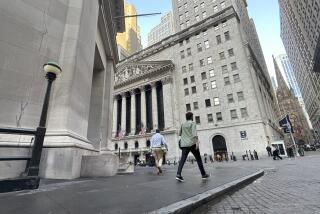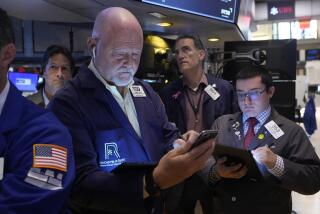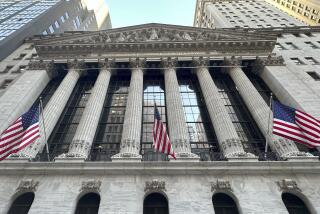FINANCIAL MARKETS : STOCKS : Late Blue Chip Buying Pushes Dow Up 18.57
The stock market opened the second half of 1990 with a moderate gain Monday, benefiting from buying that focused especially on blue chips.
The Dow Jones index of 30 industrials climbed 18.57 points to 2,899.26.
Advancing issues slightly outnumbered declines in nationwide trading of New York Stock Exchange-listed stocks, with 775 up, 744 down and 472 unchanged.
Big Board volume retreated to 130.20 million shares from Fridayâs 145.50 million.
Blue chip stocks had minor gains through most of the day, but the Dow 30 was bumped up in the final minutes of the session by a wave of buying by computer-guided traders. However, the index ended just under the psychologically important 2,900 level.
âThe last 15 to 20 minutes were all program-oriented (buying),â said C. L. Kingâs Ronald Doran.
Traders said the thinness of the trading tended to magnify the price swings.
The results of a monthly survey of corporate purchasing executives gave a slightly stronger picture than analysts had forecast of activity in the manufacturing sector of the economy.
The National Assn. of Purchasing Management said its index increased to 51.1% in June from 50.7% the month before.
Analysts said they werenât sure how or whether that bit of data might influence policy-makers at the Federal Reserve as they deliberated strategy on interest rates for the third quarter.
Trading set a slow pace throughout the session, suggesting that activity might be restrained for this whole holiday week. The markets will be closed on Wednesday for Independence Day.
Nevertheless, brokers said investorsâ enthusiasm was piqued to some degree Monday by news of a pair of takeover bids.
General Instrument, target of a $44.50-a-share bid from Forstmann Little, jumped 8 7/8 to 45 1/8 as the most active NYSE issue.
Kay Jewelers rose 3 3/8 to 14 1/4. Ratners Group of Britain launched an offer to acquire the company through an exchange of stock.
Gainers among the blue chips included Philip Morris, up 5/8 at 47 1/8; GE, up 1 1/4 at 70 1/2, and IBM, up 1 at 118 1/2.
Mattel tumbled 2 1/4 to 22 1/8. Investors apparently were disappointed in the companyâs announcement that it expects to report second quarter net income 16% above year-earlier levels. Revenue also should be 16% higher, Mattel said. âThe preliminary results demonstrate that our momentum is continuing, despite a sluggish U.S. retail sales environment,â said John W. Amerman, Mattelâs CEO.
Digital Sound of Santa Barbara, traded over-the-counter, plunged 4 1/4 to 5. The company said it was likely to post a loss for the second quarter on lower revenue, citing slower-than-expected orders from some major customers.
In foreign trading, stocks closed higher in Tokyo on a stronger yen and computer-driven program buying. The 225-share Nikkei average closed up 219.99 points at 32,160.23. Stock prices fell on the London Stock Exchange. The Financial Times 100-share index closed down 2.6 points at 2,372.0.
In Frankfurt, West Germany, stocks jumped 1.9% in lively trading as the market reacted positively to Sundayâs economic union between East and West Germany. There was a wave of buying in blue chips from both domestic and overseas investors. The 30-share DAX index surged 35.40 points to end at 1,915.30, its highest closing level since May 7.
CURRENCY: Mark, Pound Rise at Dollarâs Expense The German mark rose in foreign exchange trading, the first day of trading after the monetary union in East and West Germany over the weekend, while demand for the British pound also remained strong.
Support of the mark and pound put pressure on the dollar, which declined to levels not seen since 1988 against those currencies, according to traders.
Timothy Burton, a trader for Harris Trust & Co. in Chicago, said dealers were buying marks and sterling at the expense of the dollar.
He said a smooth distribution of marks to East Germans, starting on Sunday, was helping the mark, while sterling was supported by relatively high British interest rates and increased speculation that Britain would soon be joining the European Monetary System.
The dollar traded at 1.6515 German marks in New York, down from 1.66065, and at 1.6580 marks in Europe, down from 1.6653.
The last time it traded at those levels was in early 1988, according to Burton.
In London, the British pound was quoted at $1.7635, up from $1.7450 late Friday. A pound fetched $1.7715 in New York--an 18-month high, Burton said--up from $1.7490 Friday.
COMMODITIES: Hot Weather Ignites Pork, Bean Prices Forecasts for sizzling temperatures in the Midwest sparked sharp gains in soybean and pork futures prices amid speculation that hot weather will scorch the bean crop and slow the movement of hogs to market.
On other commodity markets, most grain futures advanced; cattle futures were mixed; oil futures mostly were lower, and precious metals rose modestly.
On the Chicago Board of Trade, soybean futures settled 5 to 23 cents higher, with the contract for delivery in July up 22.5 cents at $6.46 a bushel; wheat futures finished 0.75 cent to 2 cents higher, with July at $3.265 a bushel; corn was 3.25 cents lower to 2.50 cents higher, with July at $2.9625 a bushel, and oats were 3.50 to 3.75 cents higher, with July at $1.3925 a bushel.
In pork futures trading on the Chicago Mercantile Exchange, hogs finished 0.87 cent to 1.4 cents higher, with July at 61.27 cents a pound; frozen pork bellies were 0.95 cent to the permitted daily limit of 2 cents higher, with July at 59.67 cents a pound; live cattle were 0.27 cent lower to 0.55 cent higher, with August at 72.80 cents a pound, and feeder cattle were 0.15 to 0.57 cent lower, with August at 83.45 cents a pound.
Analysts attributed the bullish tone in pork and beans largely to forecasts that 100-plus-degree temperatures would move into the nationâs agricultural midsection from the Southwest.
CREDIT: Bonds Sluggish in Holiday Doldrums Bond prices closed virtually unchanged in a sleepy pre-holiday session, as the market had little lasting reaction to several economic reports, traders said.
The price of the Treasuryâs benchmark 30-year bond was unchanged, with its yield remaining at 8.40%, the same as late Friday.
Mike Geraty, a government securities trader with the Chicago investment firm Clayton Brown & Associates, said trading was extremely thin, with many traders and bond sales people on vacation due to the midweek Fourth of July holiday.
âItâs kind of a nothing week,â he said.
The National Assn. of Purchasing Management released its monthly survey of corporate purchasing managers, which showed that the nationâs manufacturing sector grew in June for the third straight month.
News of economic strengthening generally is viewed as unfavorable by the bond market because it implies that the Federal Reserve will see less need to ease interest rates. Lower rates benefit fixed-income investments such as bonds.
Bond prices initially dropped as much as 1/4 point on the report from the purchasing managers, but later recovered most of the losses.
The federal funds rate, the interest rate that banks charge each other on overnight loans, was quoted at 8.375%, up from 7.50% late Friday.
In the tax-exempt market, the Bond Buyer index of 40 actively traded municipal bonds rose 2/32 point to 91 13/16.
More to Read
Inside the business of entertainment
The Wide Shot brings you news, analysis and insights on everything from streaming wars to production â and what it all means for the future.
You may occasionally receive promotional content from the Los Angeles Times.










